On one hand, I would say that switching to a natural dishwasher detergent is not one of the most important product swaps to make as you switch to a low-tox lifestyle.
After all, you’re not putting it directly on your skin and you’re not really breathing it in either (except for maybe the few seconds where you’re putting it into the dishwasher dispenser).
On the other hand… using a safe dishwasher detergent is important if you think about the fact that there might be small amounts of residue left on your dishes (which you’ll then ingest when you eat or drink from those dishes).
And then of course, there’s the fact that whatever chemicals we use in our dishwashers are washed down our drains and into our waterways. There, they might not only be potentially harmful to aquatic life, but they can also make it back into our tap water (as not all of the chemicals will be filtered out by wastewater treatment plants) and our overall ecosystems (including our soil and food supply).
So, if you’re looking to make the switch to a more natural dishwasher detergent brand, I’ve got you covered. I’ve not only researched which brands have the safest ingredients, but I’ve also tested the below brands myself to make sure they actually leave you with sparkly clean dishes.
P.S. This article is specifically about dishwasher detergents. If you’re also interested in learning about the best dish soaps (for handwashing), check out this guide.
Table of Contents
- Chemicals to Avoid in Dishwasher Detergents
- Some Good News Re: Safe Dishwasher Detergents
- What About Detergent Pods?
- Okay, But Do Natural Dishwasher Detergents Actually Work?
- Also: Be Wary of Dishwashers and Mold
- Best Non-Toxic & Natural Dishwasher Detergent Brands
- Blueland (Non-toxic dishwasher detergent pods)
- Branch Basics (Safe dishwasher detergent pods)
- Rosey by Thrive Market (Most affordable non-toxic dishwasher detergent)
- etee
- MamaSuds (Natural dishwasher detergent powder)
- Truly Free (Non-toxic dishwasher soap powder)
- ECOS (Non-toxic dishwasher gel; Best option available at Walmart)
- My Picks for Non-Toxic Rinse Aids
- Natural Alternatives for Your Rinse Aid Dispenser
- DIY Non-Toxic Dishwasher Detergent Recipe
This guide contains affiliate links, which means we may earn a commission if you choose to make a purchase.
Best Non-Toxic & Natural Dishwasher Detergents (AT A GLANCE!)
- Blueland & Branch Basics (PVA-free detergent tablets)
- Rosey by Thrive Market (powdered; most affordable option)
- MamaSuds & Truly Free (also powdered)
- ECOS (gel; available at Walmart)
(You can find discount codes for a couple of these brands below.)
Chemicals to Avoid in Dishwasher Detergents
First, let’s talk about a few of the potentially harmful chemicals that are commonly found in dishwasher detergents on the market today, so that you know what to look out for.
Unnecessary Dyes & Fragrances
If you ask me, dishwasher detergents really just don’t need to be colored or scented. I mean, dishes don’t really hold scents the way textiles do. (And even if they did, do you really need your dishes to smell lemon-y?)
The problem with fragrances is that, because of what’s commonly referred to as the “fragrance loophole,” companies can legally hide over 3,500 different chemicals in consumer products without actually putting them on the label. This is one of the main ways that phthalates can sneak into consumer products. (You can read more about the fragrance loophole right here.)
The good news is that because of some recent legislation in California, brands now have to disclose specific fragrance ingredients online. Although you do usually have to dig for them, it’s still progress!
The dyes and colorants seem even more unnecessary to me. It’s just means more (mostly synthetic) ingredients you have to worry about washing into our waterways.
Harsh Preservatives
It’s important for consumer products to contain preservatives in order to prevent mold and bacteria growth, but some of them are safer than others.
Isothiazolinone preservatives (like methylchloroisothiazolinone, methylisothiazolinone, and benzisothiazolinone) are extremely common in dish soaps and dishwasher detergents (even some of the ones marketed as “green” or “clean”).
The problem with these antimicrobial chemicals is that they are irritants and can cause skin allergies upon contact. Of course, this isn’t as much of a problem when it comes to dishwasher detergent as it is for something like dish soap, which comes into more direct and frequent contact with your skin. However, some of these preservatives as also suspected to be potential endocrine disruptors, and some are also toxic to aquatic life. That means we don’t really want to be washing this stuff down our drains if we can help it.
Some Good News Re: Safe Dishwasher Detergents
While I did research for this article update, I noticed that many of the toxic chemicals that were used in dishwasher detergents even just a few years ago have been largely removed. It appears that many of dishwasher detergents on the market (even from the mainstream brands) have either been re-formulated to remove some of the worst ingredients, or they’ve been discontinued completely.
For example, sodium hypochlorite is an ingredient that used to be used a lot but I’m not seeing much anymore. (Sodium hypochlorite will release toxic chlorine gas when mixed with an acid, such as hydrochloric acid or vinegar.)
Quats used to be more common in dishwasher detergent, too. These are antimicrobials that can come with several various issues, including potential endocrine disruption, the potential to release the carcinogen formaldehyde, and contribution to the widespread problem of antibiotic resistance. Although some detergents still use quats, it appears they might be slowly being phased out.
I even found benzene—a known carcinogen—as an intentionally-added ingredient in an old (now discontinued) dishwasher detergent!
Chlorine bleach is another toxicant that’s used a lot less often these days.
It’s not entirely clear why some of these toxic chemicals are being phased out, but I suspect it probably has something to do with increasing consumer pressure for safer products. But regardless of the reason(s), it’s certainly good news!
What About Detergent Pods?
You might notice that I have removed most of the dishwasher pods from my recommendations. Now, the only “pods” that I recommend are actually more like “tablets.”
This is because it’s currently unclear as to whether the polyvinyl alcohol (aka PVA) used for laundry and dishwasher pods is truly biodegradable. Even though the plastic, water-soluble film part of the pods dissolves in the wash, it’s possible that these pods are actually contributing to micro/nanoplastic pollution in our waterways.
For this reason, I’ve decided to transition away from dishwasher pods that use PVA, at least until we know more. If you’re curious, you can read more about this issue right here.
Home
Are Laundry Pods Bad for the Environment? (PVA Plastic 101)
Could PVA in detergent pods be harming your appliances, clothes, or the environment? The jury is still out. Get the latest info about whether laundry pods are safe.
Okay, But Do Natural Dishwasher Detergents Actually Work?
I’ve tested all of the natural dishwasher detergent brands below, so I can tell you that in my experience, they do work.
I will say that I do rinse my dishes before putting them in the dishwasher, but not super thoroughly. I make sure that they don’t have any major food particles on them or anything like that, but I don’t pre-clean them like some people do.
As a side note, I have a theory (based on the fact that I have rented a lot of different homes and have therefore used a lot of different dishwashers) that whether or not your dishes get adequately cleaned has a lot more to do with the effectiveness of the dishwasher itself, as opposed to the detergent. So if you’re having a hard time getting your dishes clean, don’t forget to look into the machine itself. There might be something that needs to be cleaned or replaced.
Also: Be Wary of Dishwashers and Mold
There’s another toxin-related issue to be aware of when it comes to dishwashing machines, and that’s the fact that they are very prone to mold. This is in large part because:
- They’re constantly wet. (Moisture is a key ingredient for mold growth.)
- They have a lot of nooks, crannies, and crevices where water and little food particles get stuck.
- When you keep the door closed, there’s very little airflow, so they don’t get a chance to dry out.
For this reason, some people may choose to skip the dishwashing machine completely and just hand-wash their dishes instead. But that obviously requires more time and energy (which a lot of us just don’t have!), and it’s not always realistic if you live in a household with a lot of people in it or have certain disabilities.
So, if you do use your dishwasher, here are some pointers I have for you to prevent mold growth:
- Try to keep the dishwasher door cracked as much as possible to encourage air flow and dry it out. (Just pull the top rack out a little bit to hold the door open like 6 inches or so.)
- Wash your dishwasher’s filter at least once a month. (Once per month is what my dishwasher’s manufacturer recommends. I truly try to stick with that schedule or clean it even more often if possible because I can tell when I don’t. It starts smelling bad and drives me nuts.) I use either vinegar & baking soda and/or dish soap/all-purpose cleaner to clean mine. I let the filter soak in a bowl for a bit and then scrub it with an old toothbrush.
- Clean the nooks and crannies of the dishwasher regularly, too. Spray down the inside of the dishwasher with an all-purpose cleaner and wipe it down, making sure you get inside the little crevices where gunk builds up!
- Don’t overload the dishwasher. (This can potentially lead to improper drainage.)
- Keep an eye out for leaks or other problems. If you notice that the dishwasher isn’t draining properly, is leaving water on the floor, or something like that, make sure you stop using it until you get it fixed.
Best Non-Toxic & Natural Dishwasher Detergent Brands
Now let’s get to it! Here are my favorite non-toxic and natural dishwasher detergent brands for 2024:
Blueland (Non-toxic dishwasher detergent pods)

Price: $37 for a refill bag of 120 tablets; $0.31 per load. (You can get the Dishwasher Starter Set for $25, which comes with a Forever Tin and 60 tablets.)
Types: Fragrance-free & refillable dishwasher detergent tablets and powdered dish soap
Certifications: EWG Verified
Blueland is one of the very few brands that offers tablets (aka “pods”) that are PVA-free!
Their eco-friendly dishwasher detergent tablets are free from toxicants like petroleum derivatives, dyes and colorants, artificial fragrances, parabens, phthalates, and more.
You can get a Dishwasher Starter Set that comes with a super cute little tin, and then if you want, you can sign up for a subscription so that your pod refills get delivered to your doorstep as often as you want.

All of their products and packaging are Cradle to Cradle certified for circularity, everything is vegan, and refills are available for everything. It’s also a Climate Neutral B Corp brand as well.
Branch Basics (Safe dishwasher detergent pods)

Price: $13.50 for 40 loads; $0.34 per load
Types: Fragrance-free dishwasher detergent tablets and foaming dish/hand soap
Certifications: EWG Verified, Leaping Bunny (Cruelty-Free)
Branch Basics is basically the only other brand that offers dishwasher detergent pods that are both non-toxic and PVA-free.
If you’ve been following The Filtery for a while, you probably know that I’m a huge fan of Branch Basics! I’ve been using their Concentrate / all-purpose cleaners for years now. (You can read my full review of the brand here.) I really like how simple and safe their formulations are and how their Concentrate is truly an all-purpose product that can work for so many different things.
But, the one thing the Concentrate can’t work with is the dishwasher! That’s why they created their dishwasher tablets. They’re plant- and mineral-based and are free from animal products, gluten, and, of course, potentially harsh chemicals like sulfates, chlorine, dyes, and fragrances.
You can also sign up for subscriptions, which can save you money (and time!) each month.
I will say that for a few weeks, I was using the Branch Basics dishwasher tablets without any rinse aid in my dishwasher, and they didn’t work as well. It left a little white residue on my dishes. Once I added the rinse aid, though, it solved the problem, and now these tablets work great. (Scroll down for a couple of rinse aid recommendations.)
If you’re just starting with Branch Basics, you can use the code THEFILTERY for 15% off Starter Sets.
Rosey by Thrive Market (Most affordable non-toxic dishwasher detergent)

Price: $6 for 75 loads; $0.08 per load
Types: Powdered dishwasher detergent & pods
Certifications: Leaping Bunny (Cruelty-Free)
Rosey is Thrive Market’s cleaning product brand. Even though I haven’t had the chance to investigate the ingredients in every single product yet (it seems like they’re frequently adding more!), so far it seems like their formulations are pretty good.
Rosey got my pick for the most affordable non-toxic laundry detergent and here they win again for the cheapest safe dishwasher detergent, coming in at only $5.99 for 75 loads.
This formulation uses only six simple ingredients. No SLS, artificial fragrances, harsh preservatives, or anything like that. It utilizes the cleaning power of enzymes, which helps to break down food particles.
It comes in both Unscented and Fresh Lemon. They actually do list the fragrance ingredients on the Lemon version, and the only two they use are citral and d-limonene.
Rosey also carries detergent pods, but again, I personally am moving away from PVA pods for now.
One thing I really like about Thrive Market is how easy it is to get a bunch of your organic groceries and safer cleaning supplies in one place. I think it can definitely save you money if you do it right… But what I don’t love about it is the fact that you have to be a member to order. You can’t just put in a one-time order like you would from a normal store. (They did, however, add a monthly membership option, which is $12 per month. They used to only offer a $60 annual membership. They also offer a 30-day money-back guarantee, which is nice.)
etee
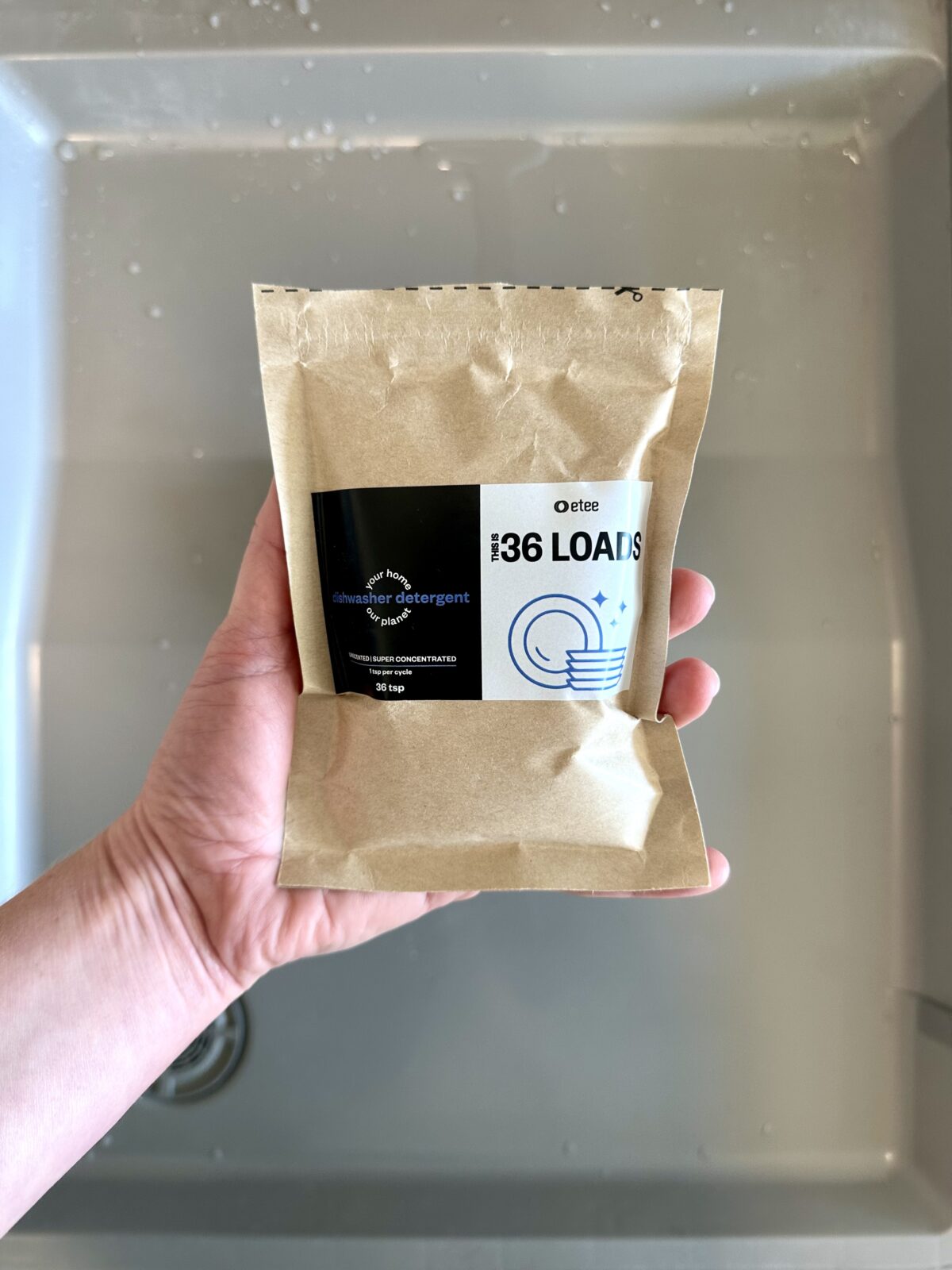
Price: $10.20 for 36 loads; $0.28 per load
Types: Concentrated automatic dishwasher powder
Certifications: None
This plastic-free powdered dishwasher detergent is suuuuper concentrated; you literally only need a teaspoon per load!
As you can see, the bag is only slightly larger than my hand, which makes it a great option for folks living in small spaces with limited storage space. (It also means there’s less of a footprint when it comes to shipping!)
You do have to use your own teaspoon though; it doesn’t come with a scooper.
Even though it doesn’t come with any third-party certifications, this non-toxic dishwasher detergent is vegan, palm-oil-free, and fragrance-free. And of course—it’s effective!
You can use the code THEFILTERY for 10% off your order.
MamaSuds (Natural dishwasher detergent powder)

Price: $23 for 60-90 loads; $0.38-$0.26 per load
Types: Automatic dishwasher powder
Certifications: Leaping Bunny (Cruelty-free)
If you prefer to shop from small businesses, then you might want to check our MamaSuds. (It’s made “Made by Mamas, FOR Mamas”!)
This eco-friendly dishwasher detergent comes in plastic-free packaging. You can get a scoop with it the first time you buy it, and then skip the scoop when you order your refills. And speaking of refills, you can save 15% when you sign up for a subscription.
I really like the fact that this vegan, natural dishwasher detergent is made with as minimal ingredients as possible. It’s literally only: non-GMO citric acid, sodium bicarbonate, sodium percarbonate, and sodium carbonate.
But it gets my dishes clean!
If you’re not sure and want to try out the dishwasher detergent first, you can actually order a sample for $5!
MamaSuds also carries other natural cleaning products as well, including a dish soap block, laundry detergent, all-purpose cleaning spray, and more.
Truly Free (Non-toxic dishwasher soap powder)
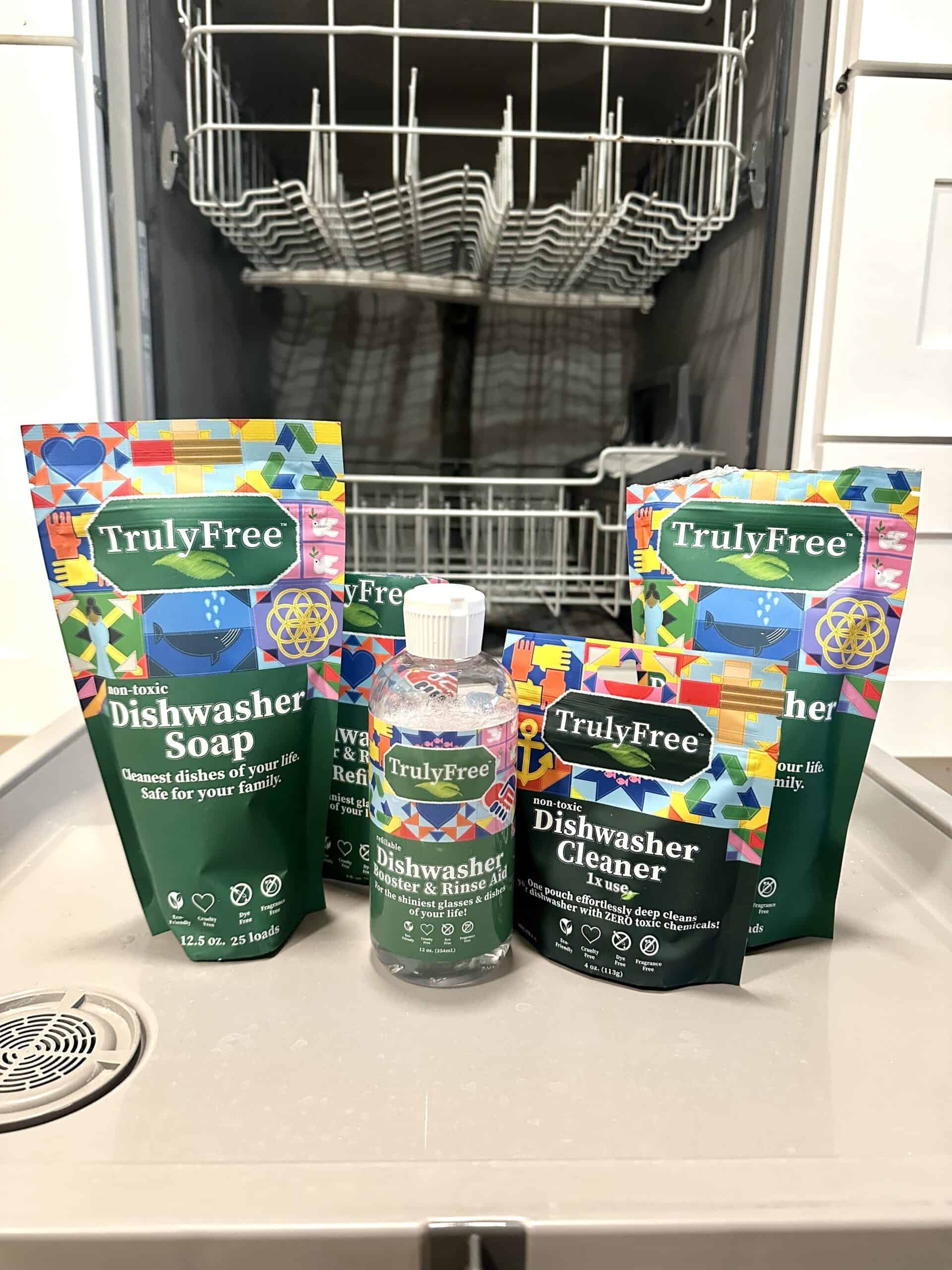
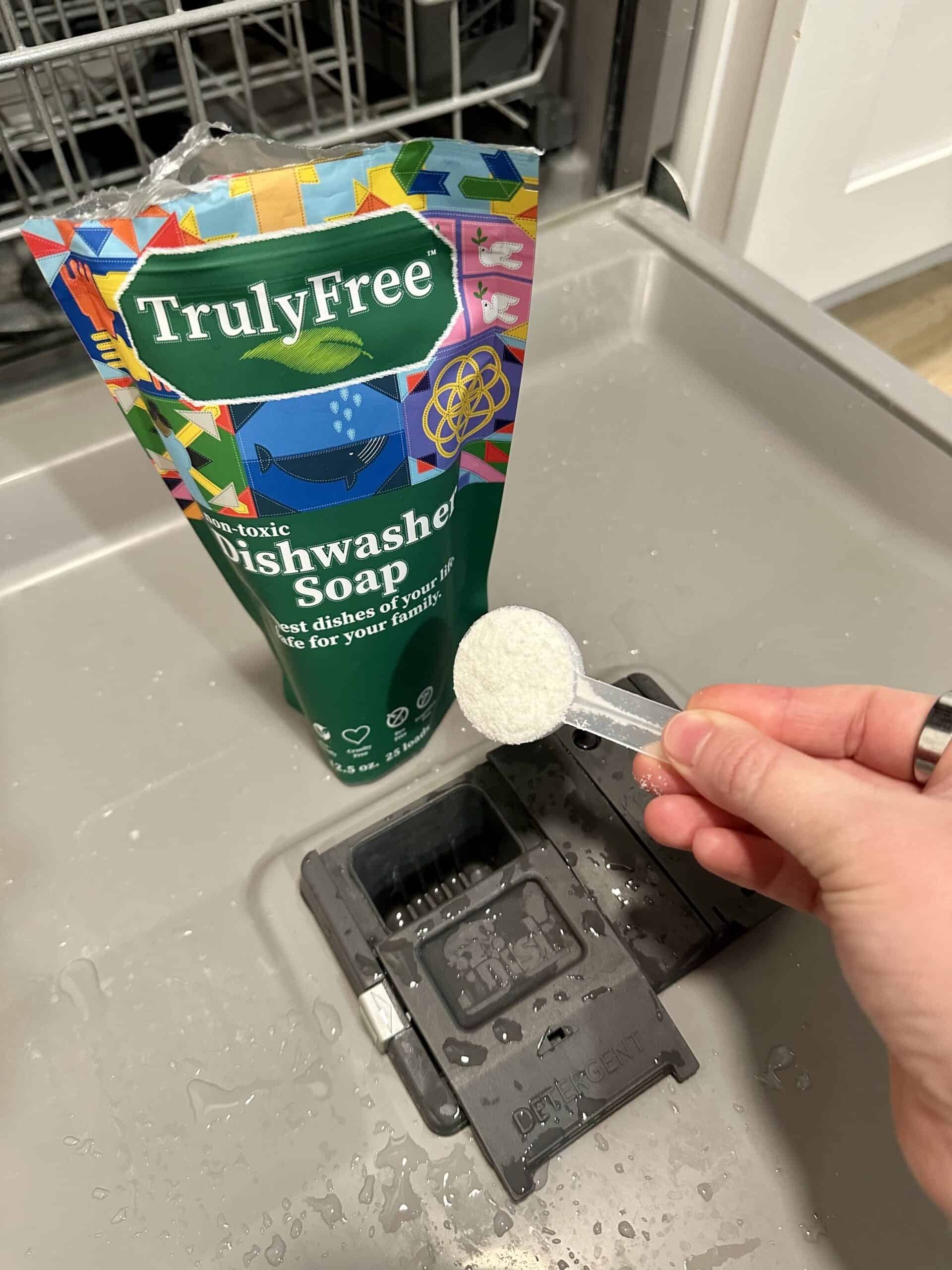
Price: $23 for 50 loads; $0.46 per load
Types: Dishwasher soap powder
Certifications: None
Truly Free has just about every kind of dish cleaner you need: regular dish soap, dishwasher detergent, dishwasher cleaner, heavy duty pot & pan spray, stone & steel cleansing polish, and more.
Their formulations use safe minerals, salts, and plant-based ingredients that are free from things like parabens, phosphates, SLS, and much more.
Even better, a lot of their products (though not all of them) are refillable for a lighter environmental footprint.
Truly Free’s dishwashing detergent has a higher price point than most of the other brands here, but if you want to give it a try and save some money, you can use the code THEFILTERY for 30% off your order. (You can also save 10% by signing up for a subscription.)
ECOS (Non-toxic dishwasher gel; Best option available at Walmart)

Price: $22 for 40 fl oz (roughly 20 loads); $1.10 per load
Types: Dishwasher detergent gel
Certifications: EPA Safer Choice, Leaping Bunny (Cruelty-Free)
It must be really difficult to formulate a non-toxic liquid/gel dishwasher detergent because there are very few options!
ECOS’ dishwasher gel is one of the only ones I’ve been able to find that is made without any harsh chemicals. (It looks like a couple of the other ones I’ve used in the past are no longer being manufactured.)
It’s available in both Free & Clear and Lavender. The Lavender version uses lavandula hybrida (lavender) oil and linalool—so no synthetics.
Plus, it’s available at Walmart, which is convenient if you’re out running errands and need to grab something.
P.S. I tried to find a good option that’s available at Target too, but I honestly couldn’t find any dishwasher detergents I feel great about recommending. I would say Seventh Generation’s gel is the best option, but it does contain isothiazolinone preservatives, which can be irritating. So if you use that option and have sensitive skin, I would just recommend washing your hands after loading the dishwasher.
My Picks for Non-Toxic Rinse Aids
Personally, I don’t always use rinse aids in the dishwasher; it usually depends on the specific dishwasher and detergent I’m using at the time. Sometimes I let it run out and then only add it back if I notice residue on the dishes. After all, it’s just one more product that I might not need for which I have to wonder about the ingredients!
Anyway, there aren’t a ton of options for non-toxic rinse aids, but here are the ones I’ve used and like:
Rosey by Thrive Market
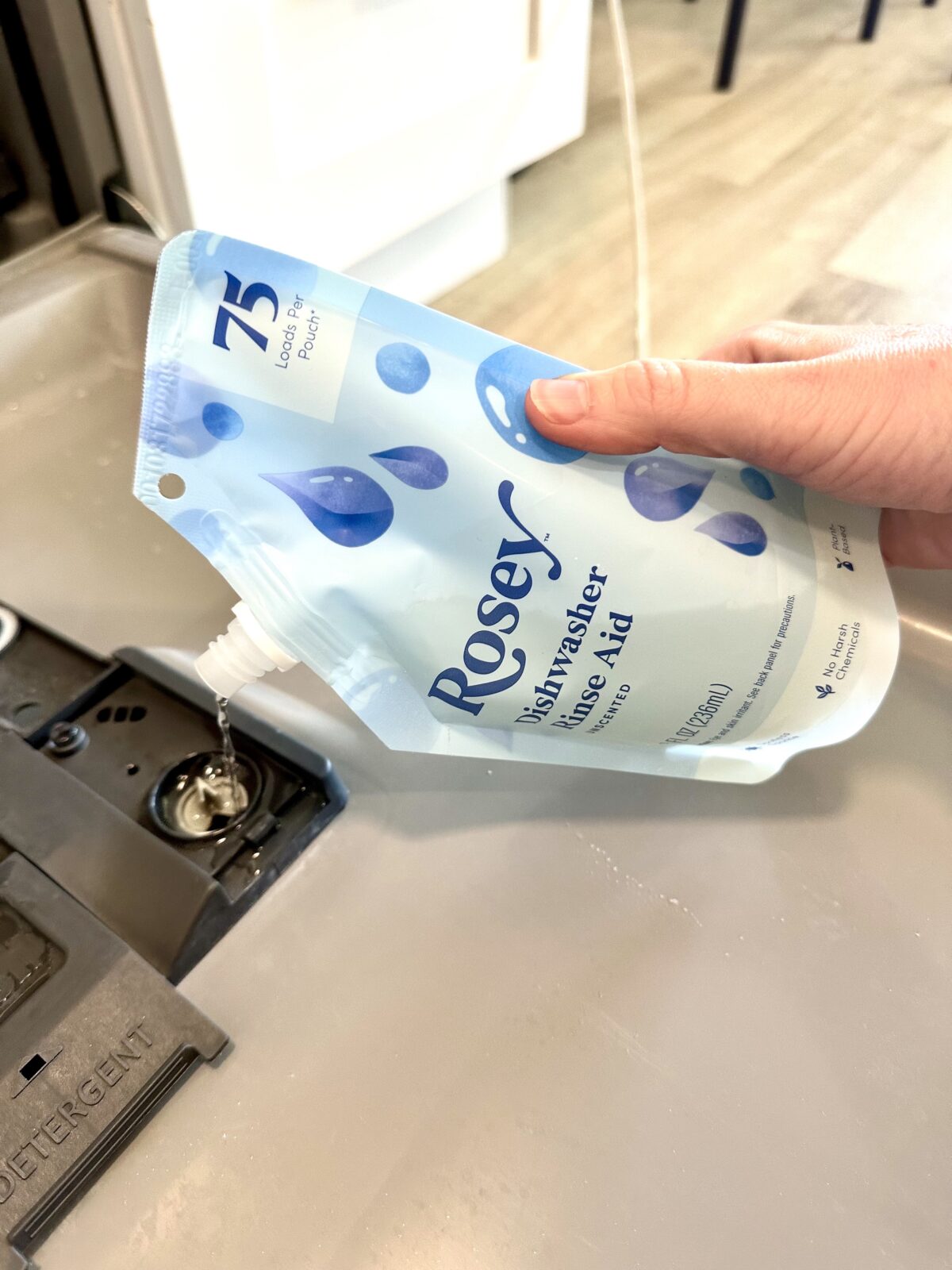
Price: $4
You probably remember that Rosey’s dishwasher detergent powder is featured above, so you can grab both the detergent and the rinse aid at the same time if you want.
This rinse aid is made with minimal ingredients and is fragrance-free. It’s also made in the USA and is Leaping Bunny Cruelty-Free certified as well.
I’ve been using the Rosey rinse aid for a couple of months now and I haven’t had any issues! It definitely does the job by making sure there’s no residue left on my dishes after the wash cycle is complete.
Eco-Me

Price: $26
This one was kind of annoying because they don’t make it very easy to find the ingredients online. But they are: Water, Acetic Acid (Vinegar), Decyl Glucoside (Plant-Derived Soap), Caprylyl/Capryl Glucoside (Plant-Derived Solubilizer), and Citric Acid (Preservative).
It’s plant-derived, fragrance-free, and made without any endocrine disruptors, irritants, or other potentially problematic chemicals.
It’s also available at Walmart!
Nature Clean

Price: $11
Nature Clean is a Canada-based brand that offers a non-toxic rinse aid that’s made with only four ingredients.
(At the time of this writing, Nature Clean’s online store is closed for renovations, but you can grab it on Amazon.)
Truly Free’s rinse aid is a pretty good option, but it does contain potassium hydroxide, which can be harmful to the skin/eyes/ears/lungs. Potassium hydroxide is more of a problem when it’s in an inhalable form, which is obviously not the case when it comes to a liquid rinse aid. But that said, you should try not to get it on your skin, and wash your hands after putting it in the dishwasher, especially if you have sensitive skin.
Similarly, ECOS’ rinse aid is a pretty good option as well, but it does contain urea, which can potentially be irritating.
Natural Alternatives for Your Rinse Aid Dispenser
Alternatively, here are some things you probably already have at home that you can try putting into your dishwasher’s rinse aid dispenser:
- White Vinegar: This is a popular natural alternative. Its acidity helps in reducing spots and residues. Simply fill your rinse aid dispenser with plain white vinegar. It also works to neutralize odors and can help in keeping the dishwasher clean.
- Lemon Juice: Similar to white vinegar, lemon juice can be used due to its acidic nature. It may not be as effective as vinegar, but it’s worth a try if it’s what you’ve got!
- Baking Soda: While it’s not a liquid, a sprinkle of baking soda at the bottom of your dishwasher (not in the dispenser!) before you start a cycle can boost cleaning and reduce spots. However, it won’t work exactly like a rinse aid in the sense of aiding drying and water sheeting.
- Rubbing Alcohol: Some people swear by this method, although I have yet to try it myself. Add a few tablespoons to the rinse aid compartment. Rubbing alcohol can help in aiding the drying process because it speeds up the evaporation of water.
(I should also say to check the dishwasher’s manual or consult the manufacturer to ensure compatibility and avoid any potential harm to the appliance or voiding warranties. Some dishwashers may specifically advise against using certain products, like vinegar, due to potential harm to seals and components.)
DIY Non-Toxic Dishwasher Detergent Recipe
If you’d rather make your own natural dishwasher detergent, it’s pretty easy to do!
Here’s what you need:
- 1 cup Sodium Carbonate
- 1 cup Baking Soda
- 1 cup Citric Acid
- 1 tsp liquid Castile Soap (like Dr. Bronner’s or MamaSuds)
- You can also add some essential oils of your choice if you really want some scent.
Simply stir together all the dry ingredients first, then add the Castile soap (and essential oils, if using) and mix well. Use 1 tablespoon of detergent per load (or up to your dishwasher’s detergent cup full line). Store in an air-tight container (like a mason jar).
Easy peasy!
(And here are some more easy DIY home cleaning recipes.)
RELATED:
Home
Non-Toxic Dish Soap: My 8 Favorite Safe Brands for 2024
I’m giving you the best natural and non-toxic dish soaps (liquid, solid, & powdered!) that are free from harsh chemicals but will still get your dishes clean.
The next time you’re looking to replace your dishwashing detergent, skip the toxic chemicals and synthetic fragrances and get sparkling clean dishes the safer way with the clean dishwasher detergent brands recommended above!
PIN IT:



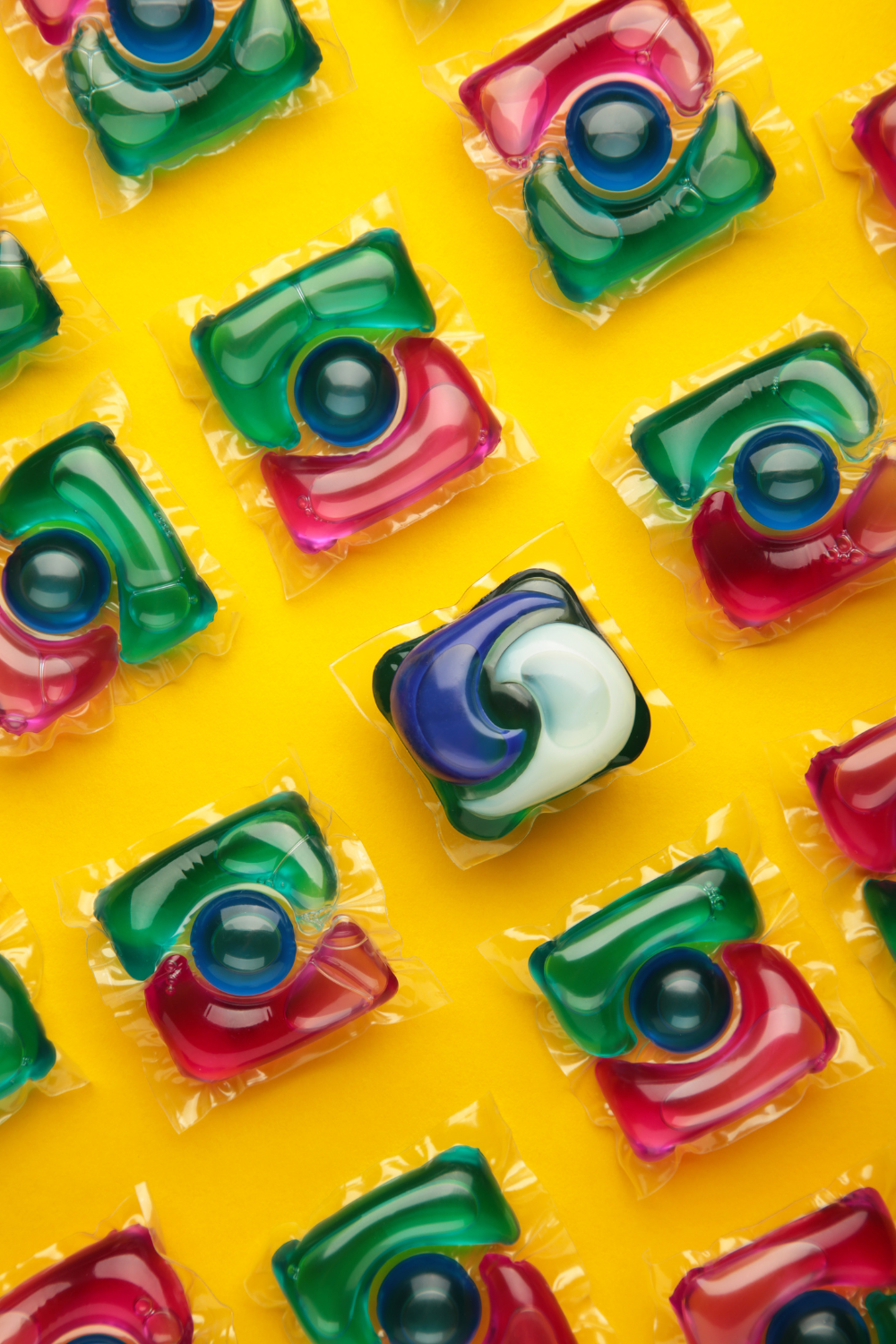
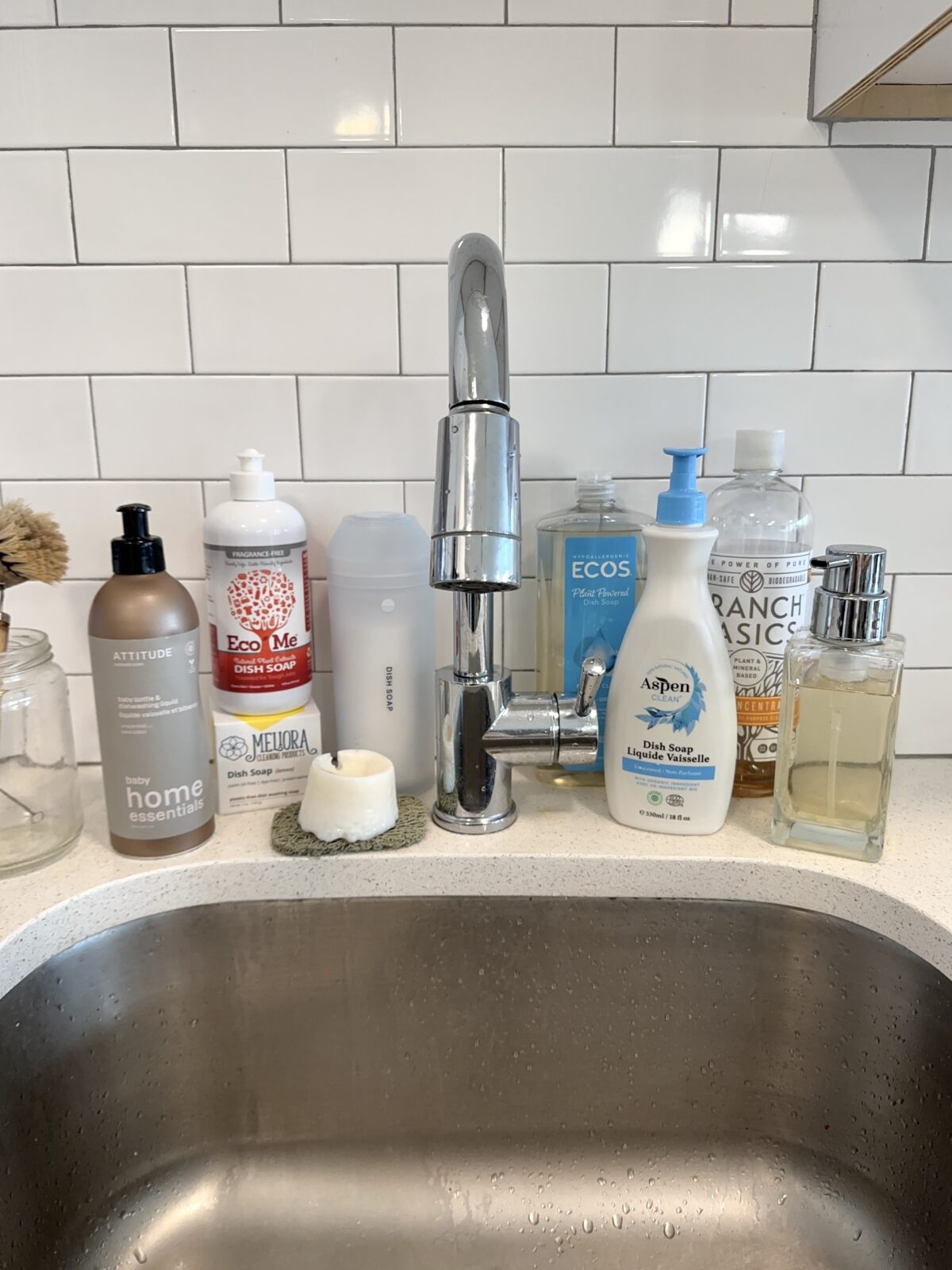

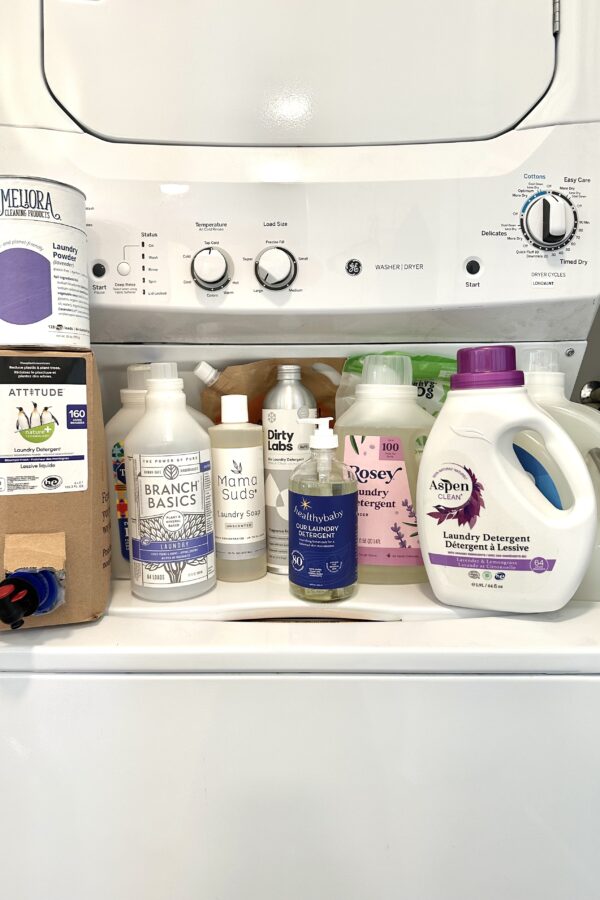
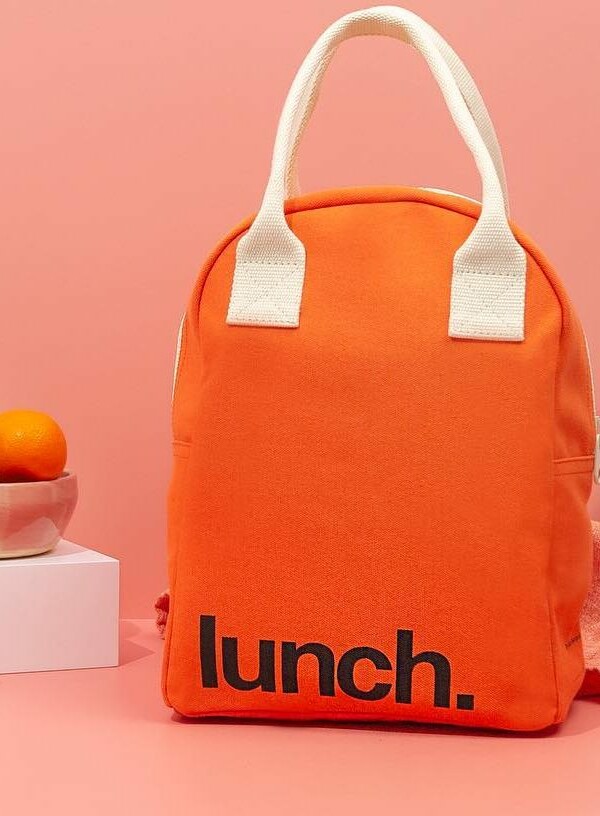
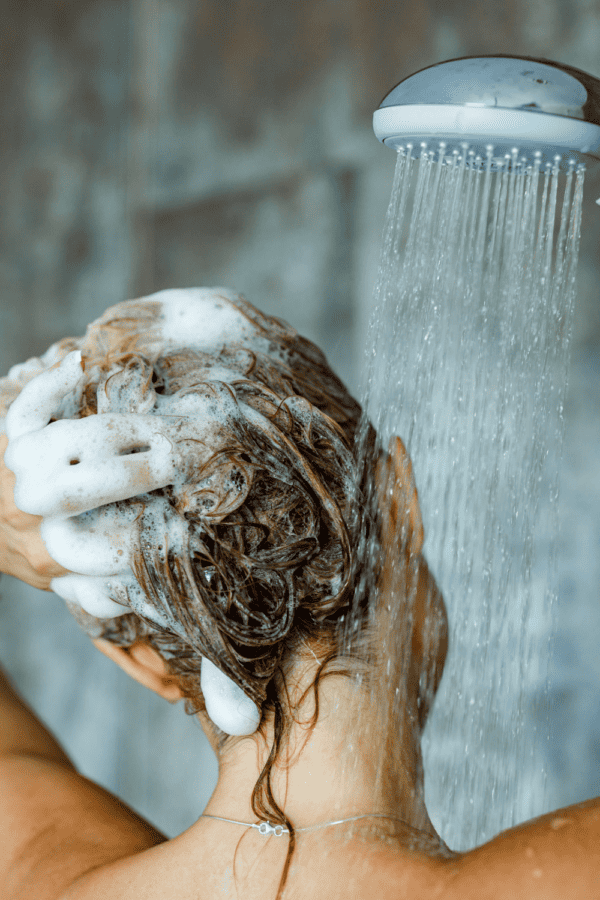
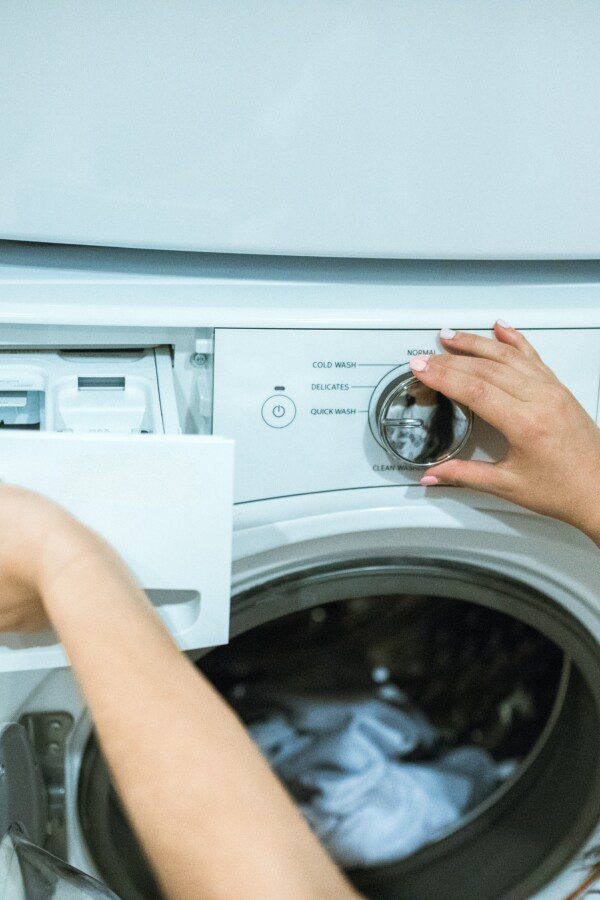
I was just looking for a dishwasher soap to use and I was hoping you would look into this and you did. Thanks.